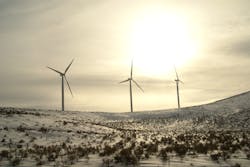Portland General Electric Power Plans Would Triple Clean Energy Resources
Portland General Electric plans to increase the clean energy it serves to customers and meet its target of reducing greenhouse gas emissions from power served to customers by at least 80% by 2030, 90% by 2035 and zero emissions by 2040.
PGE initiated its request for proposals (RFP) public process and filed its inaugural distribution system plan (DSP) at the Oregon Public Utilities Commission.
PGE made three filings at the OPUC laying out these plans. First, initiating its RFP to procure more renewable and non-emitting resources; second, filing part one of its distribution system plan, which lays out the partnership needed with customers to build the equitable grid of the future and the amount of distributed energy resources anticipated by 2030—and beyond; and third, filing an extension waiver for the next integrated resource plan.
“We are taking action to reduce greenhouse gas emissions while maintaining an affordable, reliable energy future for everyone,” said Brett Sims, PGE Vice President of Strategy, Regulation and Energy Supply. “Working collaboratively with our stakeholders, we are advancing plans to add more renewables and non-emitting resources and partnering with our customers on building an equitable, two-way electric grid.”
PGE estimates by 2030 it will nearly triple the amount of clean and renewable energy serving customers. To achieve the 2030 goal, PGE, in addition to removing coal from its portfolio, will need about 1,500 – 2,000 MW of clean and renewable resources and about 800 MW of non-emitting dispatchable capacity resources. PGE is working to accelerate its exit from the coal-fired Colstrip plant by the end of 2025.
PGE is seeking about 1,000 MW of resources by initiating its RFP public process. For customers, PGE expects to bring on about 375 - 500 MW of renewable resources, the equivalent of powering an average of 135,000 homes.
If beneficial to customers and in balance with affordability, PGE will work with the OPUC to evaluate the opportunity to procure additional clean and renewable resources through this RFP, with a potential target of getting up to 1/3 of the clean resources needed to meet the 2030 emissions reduction target. PGE will also be seeking about 375 MW of non-emitting dispatchable capacity resources that can be used on the hottest or the coldest days of the year, which will help ensure continued reliable service is available for all.
PGE also filed an extension waiver for the next IRP, which if approved would now be filed for consideration by the OPUC in March 2023.
By 2030, PGE estimates as much as 25% of the power needed on the hottest and coldest of days could come from customers and distributed energy resources (DERs), such as solar panels, batteries, and electric vehicles. Part One of PGE’s inaugural DSP lays out plans to build the grid of the future with its customers, one that supports a two-way energy ecosystem and empowers customers to make energy management choices to support decarbonization.
By 2030, PGE anticipates the potential for four times as much distributed solar and storage than today, bringing 500 MW of clean electricity to the grid. There are currently about 35,000 electric vehicles in Oregon, and the state has aggressive goals of adding 250,000 registered zero emissions vehicles statewide by 2025 and 1.1 million by 2030. PGE is planning for this new load and working to make sure that its system is ready. Through its future DSPs, PGE will share more on the actions it is taking to help pave the way for this transition, including the emerging technology identified through PGE’s Smart Grid Test Bed and how it interacts with the grid.
